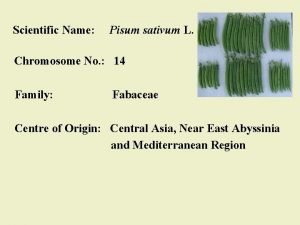Heat Stress Response in Pea Involves Interaction of










- Slides: 10

Heat Stress Response in Pea Involves Interaction of Mitochondrial Nucleoside Diphosphate Kinase with a Novel 86 -Kilodalton Protein 1

Outline 1. INTRODUCTION 2. Tissue-Specific Expression of the Pea mt. NDPK 3. An 86 -k. D Protein Is Newly Synthesized upon Heat Stress and Coprecipitates with the Pea mt. NDPK 4. The sequencing of the 86 -k. D protein 2

1. INTRODUCTION | Nucleoside diphosphate kinases (NDPKs) are ubiquitous enzymes that transfer phosphate groups from triphosphate nucleosides to nucleoside diphosphates (NDPs) (Parks and Agarwal, 1973). | Recent reports have revealed the involvement of animal NDPKs in other vital processes such as control of cell proliferation (Cipollini et al. , 1997), regulation of transcription (Postel et al. , 1993; Ji et al. , 1995), and protein phosphotransferase (Engel et al. , 1998; Wagner and Vu, 2000). | Interactions of NDPKs with different types of proteins have been reported in several cases(Engel et al. , 1998 ; Choi et al. , 1999 ; Leung and Hightower, 1997 ; Barthel and Walker, 1999). 3

| NDPK isoforms have been found in the matrix as well as in the intermembrane space of mitochondria (Troll et al. , 1993; Lambeth et al. , 1997; Milon et al. , 1997; Struglics and Hakansson, 1999). | In animals, matrix NDPK isoforms have been suggested to catalyze transfer of the phosphoryl group from GTP, produced by the TCA cycle, to ATP (Herbert et al. , 1955). | Struglics and Hakansson (1999) purified the first plant mitochondrial NDPK isoform and suggested an inter-membrane space localization. This 17 -k. D isoform, purified from pea (Pisum sativum L. cv Oregon sugarpod) mitochondria, shows auto-phosphorylation on Ser residues, which is characteristic of the human NDPK isoforms involved in signal transduction (Mc. Donald et al. , 1993; Postel et al. , 1993). 4

| Expression of NDPKs varies between different tissues and developmental stages. | Studies on heat-stress response in plant mitochondria have been mainly focused on characterization of heat shock proteins (HSPs) (Neumann et al. , 1993; Lund et al. , 1998). Only one mitochondrial small heat shock protein(Downs and Heckathorn, 1998) has been functionally studied. | Investigations of the possible involvement of other proteins such as NDPK in mitochondrial response to heat stress are therefore relevant. | The purpose of this work was to functionally characterize pea mt. NDPK, investigating tissue specificity in expression as well as a possible role in response to different kinds of stress. | We also report a novel interaction of a 86 -k. D protein with the pea mt. NDPK under heat stress, providing evidence for a role of this mitochondrial NDPK isoform in stress response in plants. 5

2. Tissue-Specific Expression of the Pea mt. NDPK Figure 1. Western analysis of the pea mt. NDPK in various subcellular fractions. Lane 1, 2 5µg of flower mitochondria; lane 2, 2 5µg of root mitochondria; lane 3, 25 µg of 7 -d-old leaves mitochondria; lane 4, 25µg of 9 -d-old leaves mitochondria; lane 5, purified pea mt. NDPK (according to Struglics and Håkansson, 1999); lane 6, 2 5µg of purified chloroplasts. 6

Figure 2. Immunolocalization of the pea mt. NDPK in flower bud and young pea leaf. Positive fluorescent immunolabelling of the mt. NDPK is seen as bright green spots. A through D, Flower bud; E and F, nonexpanded pea leaf. The pictures represent the following: A, longitudinal flower bud section incubated with anti-mt. NDPK; B, longitudinal flower bud section incubated with preimmune serum; C, transversal anthers section incubated with anti-mt. NDPK; D, transversal anthers section incubated with preimmune serum; E, transversal young pea leaf section incubated with anti-mt. NDPK; and F, transversal young pea leaf section incubated with preimmune serum. A, Anthers; O, ovary; ST, stamen; P, petals; SE, sepals; UM, upper mesophyll; LM, lower mesophyll; V, vein. Scale bars = 100 µm. 7

3. An 86 -k. D Protein Is Newly Synthesized upon Heat Stress and Coprecipitates with the Pea mt. NDPK Figure 3. Western analysis of the pea mt. NDPK in crude mitochondria prepared from pea leaves exposed to various stress conditions for 4 h. Lane 1, control; lane 2, high salt stress (400 m. M Na. Cl); lane 3, oxidative stress (2% [v/v] H 2 O 2); l a n e 4 , h e a t s t r e s s ( 4 2 ° C ) ; l a n e 4 , c o l d s t r e s s ( 4 ° C ). 8

Figure 4. Analysis of de novo synthesized protein in pea upon heat and cold stress. A, Phosphor. Image of immunoprecipitation of [35 S]Met-labeled crude mitochondrial proteins using the pea mt. NDPK antibody. Lane 1 , Control; lane 2, heat stress (42°C); lane 3, cold stress (4°C). B , Phosphor. Image of the time course of incorporation of [35 S]Met into the 86 k. D heat stress up-regulated protein, immunoprecipitated using the pea mt. NDPK antibody. Lane 1, 2 h; lane 2, 4 h; lane 3, 8 h. C, Western blot of immunoprecipitations of crude mitochondrial proteins prepared from pea leaves exposed to various stresses probed with anti-mt. NDPK. Lane 1, Control; lane 2, high salt stress (400 m. M Na. Cl); lane 3, oxidative stress (2% [v/v] H 2 O 2 ); lane 4, heat stress (42°C); lane 4, cold stress (4°C). 9

4. The sequencing of the 86 -k. D protein | Using mass spectrometry, sequences of trypsin digested peptides were obtained. | The sequences obtained were TWFM(L/I), ATGTVT(L/I) V, and (L/I) SVPTS(L/I). | Leu and Ile have the same molecular mass and can hence not be distinguished using this method. | However, analysis of the sequences revealed no similarity with other proteins found in the databases, making identification of the 86 -k. D heat up-regulated protein impossible. | We conclude that the 86 -k. D protein is an as yet uncharacterized novel protein. 10



















